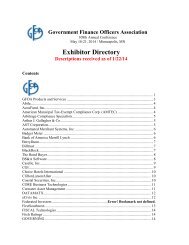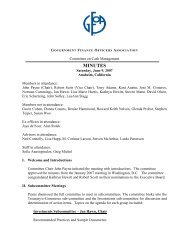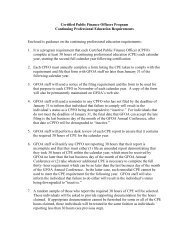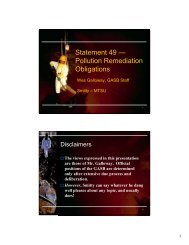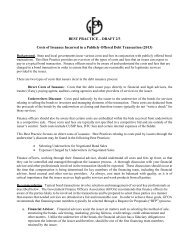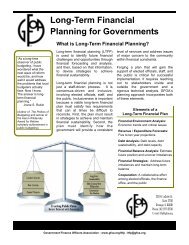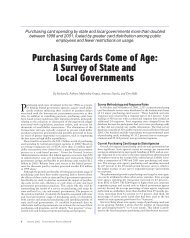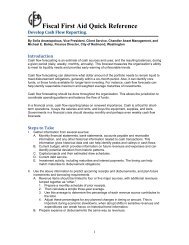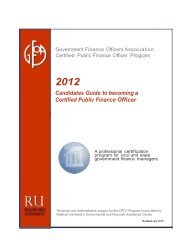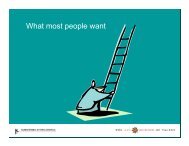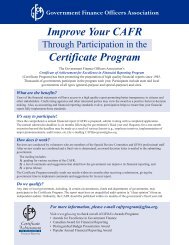Structuring the Revenue Forecasting Process - Government Finance ...
Structuring the Revenue Forecasting Process - Government Finance ...
Structuring the Revenue Forecasting Process - Government Finance ...
Create successful ePaper yourself
Turn your PDF publications into a flip-book with our unique Google optimized e-Paper software.
Exhibit 3: Results of <strong>Forecasting</strong> Technique Accuracy Experiment<br />
Mean Absolute Percent Average Percent Error Number of Times Number of Times<br />
Error for Months for Entire Year It Was Best (of 8) It Was Worst (of 8)<br />
Single Exponential Smoothing 12.38 4.46 3 0<br />
12-Month Moving Average 12.68 5.40 1 1<br />
Simple Trending 18.47 13.19 1 5<br />
Time Series Regression 15.39 9.29 3 2<br />
If you do have good knowledge of <strong>the</strong> relationships<br />
between <strong>the</strong> dependent and independent variables, <strong>the</strong> next<br />
question is whe<strong>the</strong>r large changes are expected. In <strong>the</strong> context<br />
of government revenue forecasting, large changes are<br />
most likely to occur over a long time period, so econometric<br />
methods might be more useful for long-term forecasting. If<br />
you do not expect large changes, you are probably better<br />
off using extrapolation techniques, perhaps combined with<br />
expert judgment, if your domain knowledge is good. The<br />
choice between forecasting methods is not always clear cut,<br />
and if more than one method appears useful, <strong>the</strong> results can<br />
be combined.<br />
Of course, accuracy is also important when selecting<br />
a forecasting method. The GFOA conducted a very basic<br />
forecasting experiment with historical sales tax data from<br />
seven local governments and income taxes from one, using<br />
relatively simple techniques to project revenues 12 months<br />
into <strong>the</strong> future. Econometric forecasting was excluded from<br />
<strong>the</strong> analysis since that technique is generally better suited to<br />
longer-term forecasts. The analysis focused on sales tax data,<br />
since sales taxes have <strong>the</strong> reputation of being volatile and,<br />
<strong>the</strong>refore, harder to predict.<br />
Exhibit 3 summarizes <strong>the</strong> results. Single exponential<br />
smoothing, which is a relatively simple extrapolation technique,<br />
clearly appears to have <strong>the</strong> greatest accuracy. It has<br />
<strong>the</strong> lowest percentage of error, and it was tied for <strong>the</strong> number<br />
of times it was <strong>the</strong> best-performing technique, as well as being<br />
a close second in three o<strong>the</strong>r cases.<br />
And it was never <strong>the</strong> worst-performing<br />
technique, which means that it will<br />
often be very accurate and seldom<br />
be highly inaccurate. For <strong>the</strong> entire<br />
year, exponential smoothing predicted<br />
total revenues within 3 percent five<br />
future behavior.<br />
times, and two of those times were<br />
within 1 percent.<br />
Good historical data are essential<br />
to good forecasting because past<br />
revenue patterns provide clues to<br />
The o<strong>the</strong>r techniques tested had varying degrees of success.<br />
The premise behind moving average forecasting is similar to<br />
that of single exponential smoothing, so it isn’t surprising that<br />
moving average forecasting appears to be <strong>the</strong> second-best<br />
technique, overall. The results of time series regression were<br />
mixed; on one hand, it was <strong>the</strong> best-performing technique<br />
three times (tied with exponential smoothing), and it predicted<br />
annual revenues within 3 percent on three occasions, two<br />
of those within 1 percent. On <strong>the</strong> o<strong>the</strong>r hand, it was also <strong>the</strong><br />
worst-performing technique twice, producing annual errors<br />
of 23 percent and 14 percent. In comparison, <strong>the</strong> worst error<br />
produced by exponential smoothing was 11 percent. Simple<br />
trending is clearly <strong>the</strong> worst technique, often producing<br />
substantial errors and rarely producing an accurate forecast<br />
(although it did produce <strong>the</strong> best results in one case).<br />
Given <strong>the</strong>se results, it would appear that revenue forecasters<br />
should always at least consider using single exponential<br />
smoothing, which puts a heavier weighting on recent periods;<br />
this probably explains its superior performance. Moving averages<br />
might present a reasonable secondary option, if single<br />
exponential smoothing is too complex to use, for example.<br />
Time series regression is also worth considering, but it<br />
assumes a linear relation between time and revenue yields, so<br />
you must be certain that this assumption holds. It’s also possible<br />
that larger governments will experience better results<br />
with time series regression, since <strong>the</strong> diversity of <strong>the</strong>ir revenue<br />
bases means that <strong>the</strong>re is less variability<br />
in <strong>the</strong>ir yields, <strong>the</strong>reby making<br />
it easier to “fit” a regression equation<br />
to <strong>the</strong> historical data. Indeed, <strong>the</strong> largest<br />
four governments in <strong>the</strong> GFOA’s<br />
data set had an average error for <strong>the</strong><br />
year of 3.7 percent, using regression,<br />
compared to 9.29 percent for all eight<br />
governments. Simple trending should<br />
14 <strong>Government</strong> <strong>Finance</strong> Review | October 2012



